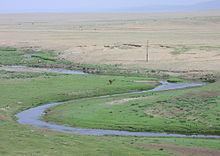 | ||
Similar Gorkhi‑Terelj National Park, Genghis Khan Equestria, Erdene Zuu Monastery, Bogd Khan Mountain, National Museum of Mongolia | ||
Mongolian manchurian grassland
The Mongolian-Manchurian grassland ecoregion, also known as the Mongolian-Manchurian steppe, in the temperate grassland Biome, is found in Mongolia, the Chinese Autonomous region of Inner Mongolia and northeastern China.
Contents
- Mongolian manchurian grassland
- Cycling the mongolian steppe
- Setting
- Flora
- Fauna
- Conservation and threats
- References
Cycling the mongolian steppe
Setting
The Mongolian-Manchurian grassland covers an area of 887,300 square kilometers (342,600 sq mi). This Palearctic temperate grasslands, savannas, and shrublands ecoregion of the Temperate grasslands, savannas, and shrublands Biome, forms a large crescent around the Gobi Desert, extending across central and eastern Mongolia into the eastern portion of Inner Mongolia and eastern and central Manchuria, and then southwest across the North China Plain. To the northeast and north, the Selenge-Orkhon and Daurian forest steppes form a transition zone between the grassland and the forests of Siberia to the north. On the east and southeast, the grasslands transition to temperate broadleaf and mixed forests, including the Manchurian mixed forests, Northeast China Plain deciduous forests, and Central China loess plateau mixed forests. On the southwest, the grasslands extend to the Yellow River, across which is the Ordos Plateau steppe.
Flora
The dominant flora consists of medium to tall grasslands, dominated by feather grass (Stipa baicalensis, S. capillata, and S. grandis), sheep's fescue (Festuca ovina), Aneurolepidium chinense, Filifolium sibiricuman, and Cleistogenes sqarrosa. The drier regions surrounding the Gobi host drought-tolerant grasses, together with forbs and low, spiny shrubs.
The southwestern slopes of the Greater Khingan range support pockets of broadleaf deciduous forest, of either Mongolian oak (Quercus mongolica), or a mixture of poplar (Populus davidiana and P. suaveolens), Siberian silver birch (Betula platyphylla), and willow (Salix rorida).
Fauna
Conservation and threats
The Mongolian-Manchurian grassland faces threat from human expansion, though in most of its eastern area, it has not been altered by agricultural as much as its reaches in western Asia, or similar grasslands in North America.
